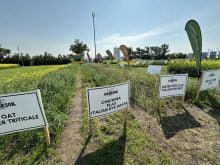Soils everywhere in the world consist of air, minerals, water and organic matter. Where the difference occurs is in the composition of soil in different places. As agricultural producers, we can only really manage the organic matter.
In a conference this winter, Jay Fuhrer, a conservationist with the Natural Resources Conservation Service in Bismarck, North Dakota, said he hears producers say, “My grandfather was a good farmer. He could grow anything. My father was good, but not as good as his dad. I’m struggling to make a living.” The reason? The grandfather was farming high-carbon soil, the father was farming medium-carbon soil and the son is farming low-carbon soils. Carbon is the energy source, stored as organic matter.
Read Also

Claas brings 1000 Series SP forage harvesters to Canada
In mid-August, Claas unveiled its new line of Jaguar forage harvesters at an event in Visalia, California, deep in the heart of that state’s dairy region.
Practices like minimum till and zero till, continuous cropping, and growing winter cereals have helped to reduce soil carbon losses, but some of our crop choices, nutrient application, loss of fences, and nutrient export have eroded carbon out of our soil. This may make some people’s blood pressure rise, but our modern practices are reducing our stable organic matter and driving many of our soils to be bacterially dominated.
Bacterial-based soils are addicted to inputs. They require nutrients, fungicides and insecticides. Bacteria-based soils can also be characterized by having high nitrates, which allow weeds to grow. This is not necessarily a “conventional” or an “organic” problem, as both systems can create a bacterial-based soil. Tillage, synthetic inputs and crop rotation influence the bacterial fungal ratio.
Adding carbon
There is a difference in the quality of carbon we can put into the soil, according to Jill Clapperton, principal scientist, founder and owner at Rhizoterra. Not only do we need to add carbon, we need quality carbon. “Low” quality carbon is not stable in the soil and will be released back to the atmosphere. Higher quality carbon will be stable and allow carbon growth in the soil. Some of the most stable carbon sources are carbohydrate, sugars and proteins. The deeper in the soil it is found, the more stable it is.
One strategy to add quality carbon is to keep plants growing throughout the season, particularly deep-rooted species. Root exudates, chemicals released by plants into the soil, help build microbial populations. As microbe populations build, especially fungi, earthworm populations start to build. This has to be incorporated with the reduction of tillage, use of synthetic inputs and a more diverse crop rotation. Once there is a better balance between bacteria and fungi, many problems start to disappear.
The other issue that keeps bacterial soil bacterial is the use of tight Brassica rotations, including canola. When producers have canola in a tight rotation, soils will be dominated by bacteria, and need high levels of inputs, especially nitrogen. When high levels of nitrogen are added to the soil, bacteria require carbon to utilize it, thus decreasing the soil carbon levels. Canola is a low carbon returner to the soil, putting more strain on the soil carbon cycle. That is why producers see yield increases by adding more inputs.
As soil carbon levels drop, water infiltration is reduced, compaction issues arise, erosion increases, nutrient use efficiency drops, root zones become reduced, root diseases become more prevalent, and so on. To change one management practice on the farm helps, but does not necessarily solve the issue. Microbiologist and founder of Soil Foodweb Inc., Elaine Ingham, said “it took a million years to build our soils, we are destroying it in 100.”
The United States Department of Agriculture has five key points to help build soils: reduce tillage, increase plant diversity, keep the soil covered, keep a living root in the soil and livestock inclusion. As the soil carbon increases, the balance of bacteria to fungi improves, and a lot of agricultural production problems start to disappear, along with the costs incurred to solve these problems. We have an agricultural sales industry that relies on our soils to be bacterial. With more balanced microbes, farming can become fun and profitable.














